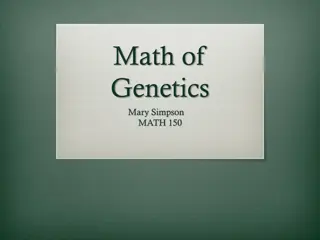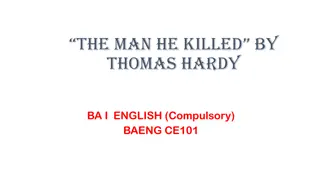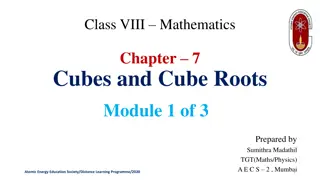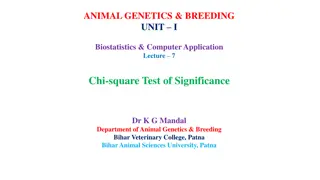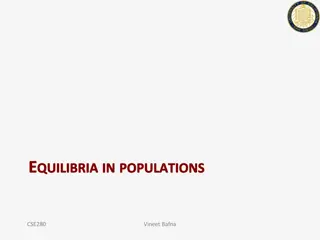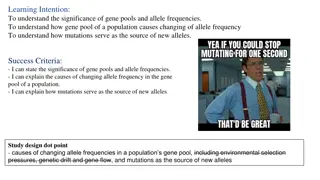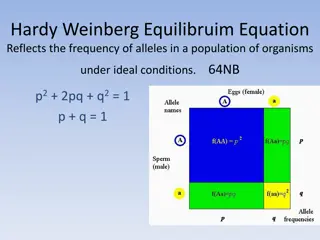Understanding Hardy-Weinberg Principle and Genetic Frequencies
Gene pool and allele frequencies play a crucial role in the Hardy-Weinberg Principle, a mathematical model predicting allele frequencies over generations. The principle outlines conditions like a large population, absence of mutations, random mating, and more. Equations such as p² + 2pq + q² = 1 help determine genotype frequencies. A worked example illustrates how to calculate carrier frequencies in a population based on a recessive condition.
Download Presentation

Please find below an Image/Link to download the presentation.
The content on the website is provided AS IS for your information and personal use only. It may not be sold, licensed, or shared on other websites without obtaining consent from the author. Download presentation by click this link. If you encounter any issues during the download, it is possible that the publisher has removed the file from their server.
E N D
Presentation Transcript
Textbook What do we mean by the following terms? Gene pool Allele frequencies
DEFINITIONS Gene pool All the alleles of all the genes of all the individuals of an entire population Allele frequencies The number of times an allele for a particular gene occurs within a gene pool
The Hardy-Weinberg Principle A mathematical model which predicts that allele frequencies will not change from one generation to the next. Relies on a number of conditions: A large, isolated population No mutations No selection of one allele over another Mating is random No net migration
The Hardy-Weinberg Principle Where a gene has two alleles: Frequency of dominant allele in a population = p Frequency of recessive allele in a population = q In any population, the total frequency of alleles is 1, therefore: p + q = 1
The Hardy-Weinberg Principle Each person has pairs of alleles, so the possible combinations of alleles are: pp pq qp qq p2 2pq q2 In any population, the total frequency of genotypes is 1, therefore: p2+ 2pq + q2= 1
Equations p2+ 2pq + q2= 1 p2 = frequency of homozygous dominant individuals 2pq = frequency of heterozygotes q2 = frequency of homozygous recessive individuals
Remember: p + q = 1 Use for allele frequencies. p2+ 2pq + q2= 1 Use for genotype/phenotype frequencies.
Worked example 1 in 25000 show a recessive condition (aa) How many people in a population of 25000 are carriers of the condition (Aa or aA)? 1 / 25000 = 0.00004 are aa (q2) q2 = 0.00004 q = 0.00004 q = 0.00632 (3 sig fig) p + q = 1.0 p = 1.0 0.00632 p = 0.99368 0.0126 of 10,000 people 0.0126 x 10,000 = 126 126 in 10,000 people carry the recessive allele But what about in 25,000? 0.0126 X 25,000 = 315 315 people carry the recessive allele in a population of 25,000 Aa or aA = 2pq 2pq = 2 x 0.99368 x 0.00063 2pq = 0.0126
Question 1 If 98 out of 200 individuals in a population express the recessive phenotype, what percent of the population would you predict would be heterozygotes? p2 + 2pq + q2 = 1
Answer 1 98/200 = (q2) 0.49 = q2 0.7 = q p + q = 1 p = 1 0.7 p = 0.3 2pq = 2(0.3)(0.7) = 0.42 = 42% heterozygotes
Question 2 2. Your original population of 200 was hit by a tidal wave and 100 organisms were wiped out, leaving 36 homozygous recessive out of the 100 survivors. If we assume that all individuals were equally likely to be wiped out, how did the tidal wave affect the predicted frequencies of the alleles in the population?
Answer 2 36/100 = q2 0.6 = q p + q = 1 p = 0.4 Heterozygous = 2 (0.4)(0.6) = 0.48 = 48% Homozygous dominant = (0.4)(0.4) = 0.16 = 16%
Question 3 Lets say that brown fur coloring is dominant to grey fur coloring in mice. If you have 168 brown mice in a population of 200 mice........ What is the predicted frequency of Homozygous dominants Heterozygotes Homozygous recessives
Answer 3 200 mice in total 168 = brown = p2 + 2pq 32/200 = grey fur = q2 0.16 = q2 0.4 = q p = 0.6 (p + q = 1) p2 = 0.36 = 36% 2pq = 0.48 = 48% q2 = 0.16 = 16%
Question 4 If 81% of a population is homozygous recessive for a given trait. Calculate Frequency of homozygous dominant Frequency of heterozygotes Frequency of dominant and recssive alleles
Answer 4 q2 = 0.81 q = 0.9 p = 0.1 p2 = 0.01 2pq = 0.18
Question 5 If 51% of the population carries at least one copy of the recessive allele what is the predicted frequency of the population expressing the dominant phenotype
Answer 5 51% = 2pq + q2 49% = 0.49 = p2 0.7 = p 0.3 = q p2 + 2pq = 0.49 + 0.42 = 0.91 have dominant phenotype
Question 8 1 in 1700 US Caucasian new borns have cystic fibrosis. calculate the frequency of the recessive cystic fibrosis allele and the dominant allele in the population calculate the frequency of non cystic fibrosis sufferers in the population
Answer 8 q2 = 1/1700 q = 0.0243 p = 0.09757 p2 + 2pq (0.09757)(0.09757) + 2(0.09757)(0.0243) 0.9567
Question 9 If 9% of an African population is born with a severe form of sickle-cell anemia (ss), what percentage of the population will be more resistant to malaria because they are heterozygous(Ss) for the sickle-cell gene?
Answer 9 q2 = 9% q2 = 0.09 q = 0.3 p = 0.7 2pq = 2(0.3)(0.7) = 0.42 = 42%
Question 10 The allele y occurs with a frequency of 0.8 in a population of clams. Give the frequency of genotypes YY, Yy, and yy. Show your work!
Answer 10 The allele y (recessive) has a frequency q = 0.8. p + q = 1, then p = 1 0.8 = 0.2 genotype: YY genotype frequency = p2 = 0.04 Yy genotype frequency = 2pq = 0.32 yy genotype frequency = q2 = 0.64.
Question 11 In the year 2374, humans finally developed the technology necessary for time travels. You are a scientist interested in the population genetics of extinct animals. Taking advantage of this technological advance, you decide to go to the past 8 million years to conduct a field work in Venezuela to study a population of Phoberomys pattersoni*, the world s largest extinct rodent weighing approximately 700 kg (1500 lb) and looking vaguely like a giant guinea pig. The coat color of this rodent varies between tan (dominant) and brown (recessive). Assume the population is in Hardy- Weinberg equilibrium. You observed 336 tan Phoberomys and 64 brown Phoberomys during your study. What is the frequency of the homozygous recessive genotype What is the allelic frequency of the dominant (tan) allele in the population? Of the animals you observed, how many were heterozygous?
Answer 11 There are 336 + 64 = 400 animals in the population. 64 are homozygous recessive (brown) Frequency of homozygous recessive = q2 = 64/400 = 0.16 Since q2 = 0.16, take the square root to get q = 0.4 p + q = 1 (formula for allele frequencies) Frequency of the dominant allele p = 0.6 Since q2 = 0.16, take the square root to get q = 0.4 Remember that p + q = 1 (formula for allele frequencies) Frequency of the dominant allele p = 0.6
Question 12 You make another trip to Venezuela and this time you observe 650 animals. How many of the 650 animals would you expect to be tan, assuming the population is still in Hardy-Weinberg equilibrium? How many of these tan animals are homozygous for the dominant allele? How many of these 650 animals would you expect to be brown, assuming the population is still in Hardy-Weinberg equilibrium?
Answer 12 If the population is still in H-W equilibrium, then the allele frequencies would be the same: p = 0.6, q = 0.4 The tan phenotype = p2 + 2pq (0.6)2 + (2)*(0.6)*(0.4) = 0.84 0.84 * 650 = 546 tan p2 = (0.6)2 = 0.36, (0.36)*(650) = 234 Brown animals are homozygous recessive Frequency of brown is q2 = (0.4)2 = 0.16 (0.16)*(650) = 104
Question 13 As you observe the animals, you count 200 brown Phoberomys and 450 tan. Conduct a chi-square test to determine if your observations are significantly different from what you expect.
Chi square In every 2-test the calculated 2 value will either be (i) less than or equal to the critical 2 value (ii) greater that the critical 2 value. If calculated 2 critical 2, no statistically significant difference Greater than 5% Probability that (differences in) results are due to chance; Accept null hypothesis If calculated 2 >critical 2, there is a statistically significant difference less than 5% probability that (differences in) results are due to chance; reject null hypothesis
Answer 13 The calculated X2 is 105.5 There are 2 phenotypes (brown and tan), so there is 1 degree of freedom (2 1 = 1) The theoretical X2 for 1 degree of freedom is 3.841, which is much smaller than our calculated one. Therefore, we reject the null hypothesis that the population of 650 is in H-W equilibrium. Our observations are significantly different from our espectation, assuming H-W equilibrium.
Question 14 past paper In a study of people living in India, the frequency of the IO allele was found to be 0.55and that of the IA allele, 0.18. What was the frequency of the IB allele in this population?(1) 1. 2. In a village with a population of 500, there were 8 people who were homozygous for the sickle cell allele and 96 who were heterozygous. Calculate the frequency of the HbS allele in the village. Show your working.
Answer 0.55 + 0.18 + x = 1 1. x = 0.27 2. 500 people = 100 alleles in total 8 people homozygous recessive = 16 copie sof sickle cell allele 96 heterozygous = 96 copies of sickle cell allele total occurrences of the allele = 96 + 16 = 112 112/1000 = frequency = 0.0112
Question 15 past paper Warfarin is a substance which inhibits blood clotting. Rats which eat warfarin are killed due to internal bleeding. Some rats are resistant to warfarin as they have the allele WR. Rats have three possible genotypes: WRWR: resistant to warfarin WRWS: resistant to warfarin WSWS: susceptible (not resistant) to warfarin. In addition, rats with the genotype WRWR require very large amounts of vitamin K in their diets. If they do not receive this they will die within a few days due to internal bleeding. 1) A population of 240 rats was reared in a laboratory. They were all fed on a diet containing an adequate amount of vitamin K. In this population, 8 rats had the genotype WSWS, 176 had the genotype WRWS and 56 had the genotype WRWR. Use these figures to calculate the actual frequency of the allele WR in this population. Show your working. 2) The diet of the rats was then changed to include only a small amount of vitamin K. The rats were also given warfarin. How many rats out of the population of 240 would be likely to die within a few days? (1) 3) In a population of wild rats, 51% were resistant to warfarin. Use the Hardy-Weinberg equation to estimate the percentage of rats in this population which would be heterozygous for warfarin resistance. Show your working.
Answer 240 rats = 480 alleles Total WR = 56*2 + 176 = 288 WR frequency = 288/480 = 0.6 56 + 8 = 64 49% = q2 0.7 = q p = 0.3 2pq = 2(0.3)(0.7) = 0.42 = 42%
Question 16 past paper In the flour beetle, the allele for red body colour (R) is dominant to the allele for black body colour (r). A mixed culture of red beetles and black beetles was kept in a container in the laboratory under optimal breeding conditions. After one year, there were 149 red beetles and 84 black beetles in the container. Use the Hardy-Weinberg equation to calculate the expected percentage of heterozygous red beetles in this population
Answer total number beetles = 233 frequency of black (q2) = 84/233 = 0.36 q = 0.6 p = 0.4 2pq = 0.48



